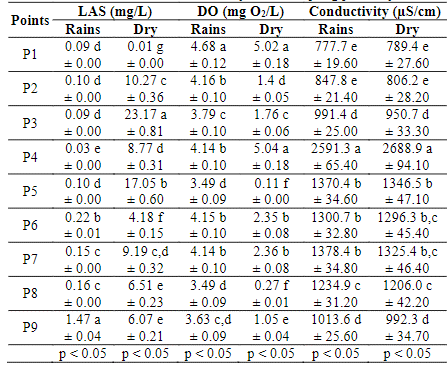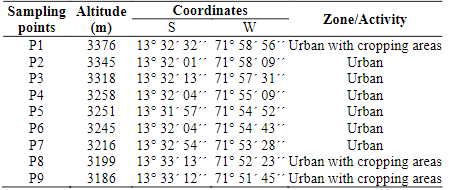1- Introduction
Emerging organic chemical compounds are resistant and have been shown to cause harm to the environment and human health [1,2], and the potential for toxicity when present in wastewater is still unknown [3], therefore, no acceptable limits have been established for those compounds [4], and furthermore, their exact chemical interaction is unknown [5].
Surfactants are widely used in household and industrial products, which are discharged like wastewater after use [6,7]. This account for further investigation about destination and impact of surfactants in the environment after release in sewage [3].
Due to their wide applicability, profitability, and level of consumption many commercial detergents contain anionic surfactants, including linear alkylbenzene sulphonates (LAS), being this the most important [5]. In general, commercial products contain between 25 to 30% of LAS, either as wetting agents, emulsifiers, foaming agents, in agricultural products, and pigments or paints [8].
It has been verified that LAS is aerobically biodegradable in wastewater, and its use is considered environmentally friendly [9]. According to Asok et al. [10], more than 90% are rapid biodegraded, approximately within 4 days. In addition, it was observed that biodegradation in absence of oxygen is not favorable [3].
LAS can cause harm in aquatic life and it is important to determine the concentrations in water to estimate the possible danger to aquatic organisms and living organisms [11]. Bioaccumulation creates a risk for organisms beyond the food chain due to the ability to absorb organic compounds [1], according to Ying [12] and Montagner et al. [13], concentrations higher than 0.1 mg/L of alkylphenols stimulate vitellogenin production in male fish, and its behavior in high Andean areas, above 3000 m altitude is not known.
Rivers and lagoons near urban areas receive discharges of wastewater, where there are not sewage treatment plants to reduce LAS residues, making the ecosystem a vulnerable place. So, the aimed of this study was to determine the level of LAS surfactants in the high Andean micro basin of the Huatanay river; in Cusco city, Peru at 3400 m of altitude.
2. Materials and methods
The study was carried out between January to July 2018. The water samples were taken along the Huatanay micro-basin river that belongs to the Vilcanota basin in Cusco (13° 31′ 06″ S, 71° 58′ 41″ W, and 3400 m of altitude). According to Köppen climate classification, the micro-basin has a Subtropical highland climate (Cwb), It presents well defined seasons, a wet season, with intense rainfall between October to March (from 500 to 1000 mm/year) and temperatures from 5 to 23°C; the dry season between April to September with temperature from 4 to 22°C. It presents an average relative humidity of 55%. Fig. 1 shows the distribution of rainfall during the experimental period.
Nine points were selected along the river covering the urban area as shown in Table 1. The points vary from 3376 to 3186 m of altitude, and they are located along of 15.3 km and with a slope of 1.24%. The collecting samples were carried out in the afternoon from 14:00 at 18:00 hours and considering a day without rain.
Water samples were stored in amber glass bottles. The bottles were treated previously with nitric acid at 3% and rinse with ultrapure water type I. Samples were immediately refrigerated on ice and stored in dark until their analysis.
The concentration of LAS was determined at the AGP Laboratory - Labs in Lima, Peru, through a UV-Vis spectrophotometer at 652 nm, according to the 5540-C methodology - Anionic Surfactants as MBAS assay with the methylene blue colorimetric indicator [14]. On the other hand, the DO and the conductivity were determined in the field using a multiparameter following the 4500-O G and 2520-B methodology for their calibration and reading respectively [14]. The reading was carried out in triplicate at each sampling point, introducing the electrode in the river water with low turbulence and then, it left it to rest for 30 seconds until stabilization.
The variability of the results was evaluated through an analysis of variance (ANOVA) at 5% of significance, a Tukey means test (p < 0.05), and the correlation through the classified Pearson coefficient. Data analysis was performed with Minitab V17 software.
3. Results and discussion
Table 2, shows the results of the LAS surfactant concentration for both seasons at the sampling points. In rains season, the point P9 reported the higher concentration (1.47 mg/L). On the other hand, the concentration of LAS increases downstream from an initial value of 0.09 to 1.47 mg/L, showing a significant difference between the sampling points (p < 0.05).
Table 2 LAS concentration, DO and conductivity at the sampling points by season

Means values with different letters are statistically significant at 5%.
Source: Authors
This happens because the river runs through the downtown and many household wastewaters are discharged into the Huatanay river; although the LAS can be diluted during rain episodes. The point P9, in particular, receives the discharge from Cusco water treatment justifying the high concentration.
In the dry season, the concentration of LAS increased considerably due to the absence of dilution by rain. However, the point P1 presents quite lower concentration (0.01 mg/L). This zone is characterized with low population density and cropping areas. As the river flows downstream, the concentration reached to 23.17 mg/L (P3). In contrast to point P1, point P3 presents characteristics of household sewage collectors and car wash areas.
The waters from the Huatanay river are intensively collected in point 9 to use for irrigation purposes especially in dry season, at this point the concentration was 6.07 mg/L, which exceeds the Water Quality Standards - Peru (WQS) that recommend a maximum of 0.2 mg/L for this type of activity (MINAM, 2017).
Jiang et al. [15] and Ying [12] mention that concentrations higher than 0.1 mg/L induce chronic toxicity and bioaccumulation in plants [1,4,16]; in the same way this sewage can cause harm or destruction to the root cell membrane, changes in membrane permeability, in fine structure and effects on physiological processes such as photosynthesis [7]. Although, LAS requires at least 4 days for completely degradation [10], twice of this time is necessary in soil under aerobic conditions [17].
Regarding dissolved oxygen, it is observed that the levels are between 4.68 to 3.49 mg O2/L (p < 0.05) in rains season, showing a tendency to decrease as the water runs down (Table 2), while in the dry season, the values are between 5.02 to 0.11 mg O2/L (p < 0.05).
At points, P3, P8, and P9 in the rains season the DO levels are below the WQS [18] that recommends values higher than 4.0 mg O2/L, while in the dry season only points P1 and P4 reach values recommended by WQS. These fluctuations are also due to the turbulence that the river presents near the sampling points [19] because it presents a 1.24% slope.
On the other hand, the conductivity shows values that vary from 777.7 to 2591.3 µS/cm in the rains season, while in the dry season shows values from 789.4 to 2688.9 µS/cm (Table 2). Conductivity increases as the downstream river flows; this fact is because detergents contribute dissolved salts into the water [20,21].
The Huatanay river receives domestic wastewater that is composed mainly by organic matter which requires oxygen for biodegradation of LAS [22]. Therefore, the decrease in the DO level would not only be attributed to the presence of LAS in the water samples. Such observation is indicated through the low negative correlation that it presents with the DO (Rs = - 0.30) (Table 3).
These reported values in most cases are lower than the stipulated by WQS for the conductivity to use as irrigation water [18]. However, the concentration of LAS presents a low positive correlation with the conductivity (Table 3) for dry season (Rs = 0.03) and rains season (Rs = 0.20), this is Ewhy LAS slightly increases conductivity.
4. Conclusions
This work presented the behavior of LAS surfactant residues and its relationship with conductivity and dissolved oxygen, in a high Andean river that crosses the urban area of the city of Cusco, located above 3400 m of altitude.
High levels of LAS detergents have been found in the Huatanay river in the dry season, which exceeds the values of the water quality standards for irrigation water, of the Peruvian regulations; the DO levels at most sampling points are below the values of the water quality standards, while conductivity is acceptable for irrigation water; the conductivity and DO, show a low negative and positive correlation respectively, with the detergent level for both seasons; so that high Andean river of the Huatanay that crosses the urban area of the city of Cusco, is contaminated by surfactants.


















